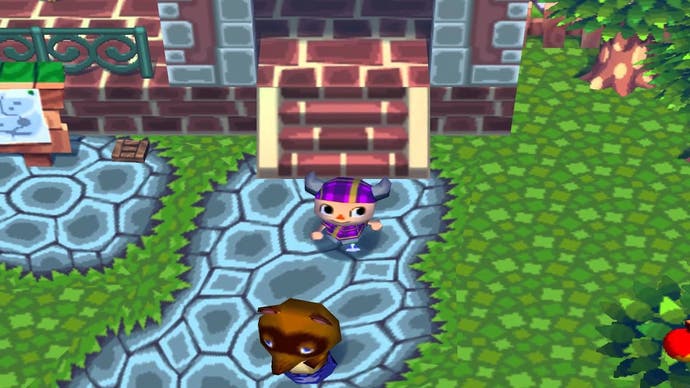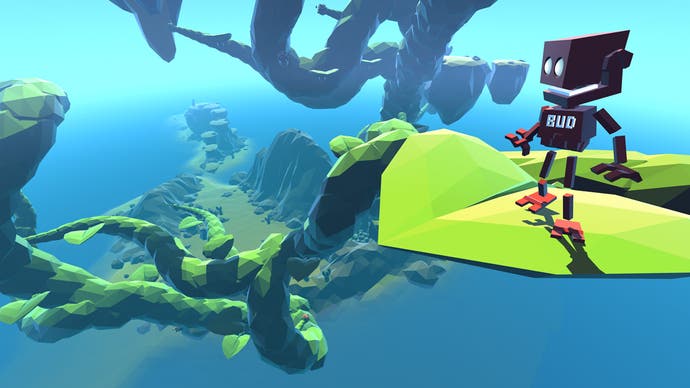You're never really outside in a video game, are you?
Skybox-mindedness.
One of the more pleasantly creepy things I like to think about when playing video games is that, even when you're outside, you're never really outside. Take Animal Crossing, as outsidey - as outdoorsy - a video game as I have ever played. In the classic original you look down on the landscape from a sweet parental distance and it's all green grass and trees and the occasional rock. Man, when the fireworks go off on certain, special evenings, you can see them reflected in the pond - in the sky above but in the water below. What could be more outside than that?
But then you walk to the edge of the village and - what's this? A polite cliff-face. Or an ocean. Or a trainline, with a hint of a tunnel that looks like it leads nowhere so much as Exit Stage Right or Left. That tunnel looks like a canvas prop in a local theatre group production. And it makes you realise that this village - shuddery thought - is hemmed in. And maybe that goes for the sky overhead, because it can't just have been left open can it?
I am very wonky about what constitutes reality in terms of the possibilities of video game geometry. Part of me still thinks that if the designers of Animal Crossing had left the roof open, as it were, your animals could accidentally travel too high and be met by a radioactive bustle of ones and zeroes, the code of the game leaking into the world of the game. Laugh at me, whatever. I am sure there is some kind of boundary up there. Some kind of vaulted roof on which the stars are merely painted. I am sure that the reality of every video game space is enclosure. Every designer must have a strategy for boundaries: how to conceal them, how to make them natural, how to guide the eye and the feet away from their illusion-shattering surfaces.

On the bus ride in today - I am re-reading Reyner Banham on Los Angeles, so it would be really handy if you were to blame him once you realise this piece is even more aimless than usual - I suddenly understood that it doesn't actually matter if I'm right or wrong about enclosure anyway. It doesn't matter if there's an example somewhere of a game world open to the void or if I've fundamentally, shamefully misunderstood the way that games are built, assuming that in every game that presents a sky there must also be - is this the word? - a skybox.
It doesn't matter because I think players believe it to be so, consciously and sometimes unconsciously. This is the model a lot of us have in our heads. And the reason this is interesting to me, I think, is because it gets its fingers on a thought I've often brushed against but never been able to reach: the dance of conscious and unconscious thinking about boundaries that occurs when we play games.
Let me give you an example that's fresh in my mind, because I've been playing it all week. Dauntless is the new Monster Huntery game that's hoping to do a Fortnite on PC and consoles right now. I sort of love it. You leave your hub - amusingly for anyone from Kent it's called Ramsgate - and venture out into the shattered world to bring down massive beasts and turn them into garments and weaponry. Then you do it all again, slightly more competently with any luck, and the whole thing starts to loop. But after a week of playing I've found that I don't really like to leave Ramsgate any more. There's almost nothing to do in the hub, which is designed as a small city, a gateway at one end giving way to a series of stacked streets and public spaces. But it's hard to pull myself away from it nonetheless.

What have I been doing? The things that I'm allowed to do: crafting things, collecting missions, seeing what NPCs have to say. But I've also been doing what I think we all do in games once we've been in a space long enough: testing the boundaries. This is often unconscious, I suspect. I suspect it only becomes conscious very occasionally. I will find myself wandering around a street and trying to get into the space between houses and I'll realise: oh, I must be looking for invisible walls.
Invisible walls! We're meant to hate them in games. Ending the fun. Breaking the spell. But what's amazing is that they don't really break the spell. They don't break it for very long anyway. You find one and you realise - oh, this world is false. But you already know this world is false because you bought it or you downloaded it and it has rules and UI and a start screen and maybe it came with a booklet. Then the invisible walls become a game. Where are they placed? How do they operate?
Ramsgate has a few obvious invisible walls. One over by the gate for starters, I think. But it has lots of them around fiddly things where you might simply get stuck. The alleyways between houses are needed to sell the fiction, but you shouldn't be able to walk through them because the space would become too complex and elbowy, and so: invisible wall. Equally, I love sounding out the railings in Ramsgate (I am boring): some of them you can hop over, others which you should also be able to hop over will not let you. Invisible wall!

You know where this leads. It leads to the inevitable conclusion that Ramsgate is not a real place. And I know that and I always knew that. But in the superpositioning that is required when playing a video game, I also forget that I know that. I think: oh, I'll go and see what's happening in Ramsgate. I'll talk to the Blacksmith. I'll check out that machine that sometimes chucks out orbs. But I do all this while knowing that nobody actually lives in any of the houses, that most of the doors will never open, that the whole place is, in essence, a menu more than a city.
Banham says early on in his book on LA that he had to learn to drive in order to read the city, a city whose language was movement. "Like earlier generations of English intellectuals who taught themselves Italian in order to read Dante in the original, I learned to drive in order to read Los Angeles in the original." It strikes me, and maybe I've just been staring at my computer too much this week, that this movement between different layers of credulity - it's a game, but it's also a place, but the place is thin, but the thinness is not noticeable or important - is a crucial part of reading games in the original. These places are made for us. If they have puzzles for us, these puzzles have already been solved by the people who set them, the people we try not to think about, just as we try not to think about the ten other people queuing to talk to the quest giver in the town square. Overhead are stars, which are beautiful, but the stars are painted on some kind of barrier - they must be. But the barrier itself is also beautiful, and interesting in and of itself, and crucial to the reality of what a game's reality actually is.

